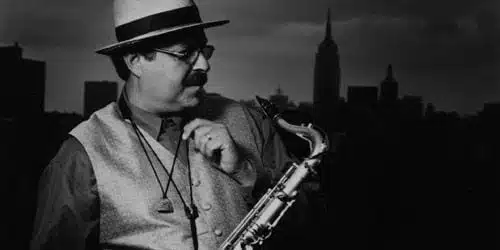
One of the marvelous, revolutionary things about jazz is the manner in which regeneration is written into its DNA. Jazz musicians may play in the same tunes or in the same style for all of their careers, yet they still make music new every time they play. If done sincerely, the art of improvisation makes art continually new. A great jazz musician changes his invention as life changes him.
And so Joe Lovano’s 22nd album for Blue Note Records manages to surprise and captivate even as it provides us something utterly reliable: a searching saxophonist with deep musical intelligence. Folk Art comes from Lovano’s new quintet, an ensemble that is both earthy and otherworldly. Pianist James Weidman brings both gospel grounding and “out” experience from downtown. Otis Brown brings the drive of hard bop as well as freedom on drums, while Francisco Mela comes from Cuba as a daringly polyrhythmic drummer. Bassist Esperanza Spalding brings a youthful drive and inexhaustible melody. This is a working group rather than a clever one-off, and its output here suggests the chemistry and continual dialogue of a real jazz group, hard at work.
The program that Lovano puts before his group is all-original and sweeps over the full range of the modern jazz language: groove tunes, free ballads, swingers, and wide-open harmonic fields of play. Absent is any kind of gimmick — no jazz transformations of contemporary pop tunes, no jazzifying of opera, no special guests, no string quartet. Rather, just home-cookin’, with Lovano’s many reeds (tenor sax, straight alto, taragato, alto clarinet, and aulochrome) tough and tender in equal measure.
This date is particularly wide open, taking on many of the sounds of jazz in the 1960s and 1970s. The band is loose enough to make this a great virtue, with the two drummers leaving great spaces open in the music and limited amounts of predetermined melody or structure presented by the leader. “Drum Song” features Lovano’s taragato, a Hungarian folk instrument that sounds like a keening soprano saxophone, dancing about a spare drum groove in fanciful swirls and moans. Eventually Spalding joins by playing highly vocalized lines, and then Weidman carpets the proceedings with harmonically suggestive chords. At its core, however, “Drum Song” is an eight-minute collective improvisation, and one that rivets your interest.
Even the most structured tunes have a sense of adventure. “Song For Judi” (Judi Silvano, the leader’s wife) is a lovely ballad. But it begins with a long solo piano passage, and then the melody for tenor sax moves through several keys without losing its serpentine elegance. “Powerhouse” has the drive of a straight hard-bop cooker, but the melody and chords lurch oddly in certain places, giving the tune both crackle and a touch of shock. The title tune, “Folk Art”, starts with a simple repeated vamp/melody in a kind of round among he various instruments, but it busts out into a free solo over the groove, then a duo for the drummers, then into a driving swing for Weidman and Lovano to flow over.
As one of the best saxophonists in jazz, Lovano increasingly seems more and more himself on all his horns. If he once seemed like the kind of brawny, aggressive player that might have come out of Texas, then experience keeps demonstrating that Lovano prefers a fuzzy, cozy tone and attack. While he is capable of steely runs when the time is right, Lovano mostly blurs his playing for effect. His sound pulsates and comes muted quite often, achieving an intimate or confessional tone even as he executes difficult passages. Particularly on tenor, Lovano avoids the major influences (Coltrane, Rollins, Shorter) and seems to take on a slightly impressionistic feeling.
On alto and soprano, Lovano’s tone is more exotic and keening — with his championing of the duel-soprano sax (the “aulochrome”) being the most distinctive and even strange element of his art. His tone is less than pretty, reaching for beauty in a slight sharpness. In this way, his greatest influence would seem to be Ornette Coleman. He pays tribute to Coleman here with “Ettenro” (“Ornette” spelled backwards), a playfully free track that captures all five of the musicians in “Us Five” speaking with equivalent voices. The twin drummer pass the syncopations back and forth between them when Lovano switches to tenor, and then Weidman pulls the rhythm section into a free conversation that demonstrates the kind of authority and imagination usually commanded by Andrew Hill or Jason Moran. Lovano plays an Ornette-ish kind of innocence on his clarinet feature, “Page Four”, laying out a mysterious melody that invites deeply melodic improvising from Spalding and Weidman.
Though Lovano is inevitable the star, turning in one fascinating solo after another, it’s the pianist who emerges from Folk Art in a new light. Weidman is a veteran sideman and accompanist of top vocalists (Abbey Lincoln and Cassandra Wilson), but Us Five lets Weidman cavort as an equal with four other players. Not only are Weidman’s solos dangerously fun — by being lyrical, propulsive, and daring at once — but his ensemble work always seems to ground the band in a sense of sprawling immediacy. Weidman creates the funk when the funk is called for, and he soothes the heart when that’s the necessary mood.
At this stage of the game, Joe Lovano’s name guarantees a certain level of quality in jazz. His boundless imagination has promised great playing, but it has also generated a somewhat restless recording career, with a different band or approach on nearly every recording. With Us Five, Lovano has found a flexible and exciting working band, a group that can play down the center or off on the side, that can swing joyously or reach for the heights of abstraction.
Here’s hoping that Lovano and Blue Note love this band as much as it deserves to be loved. More please.
